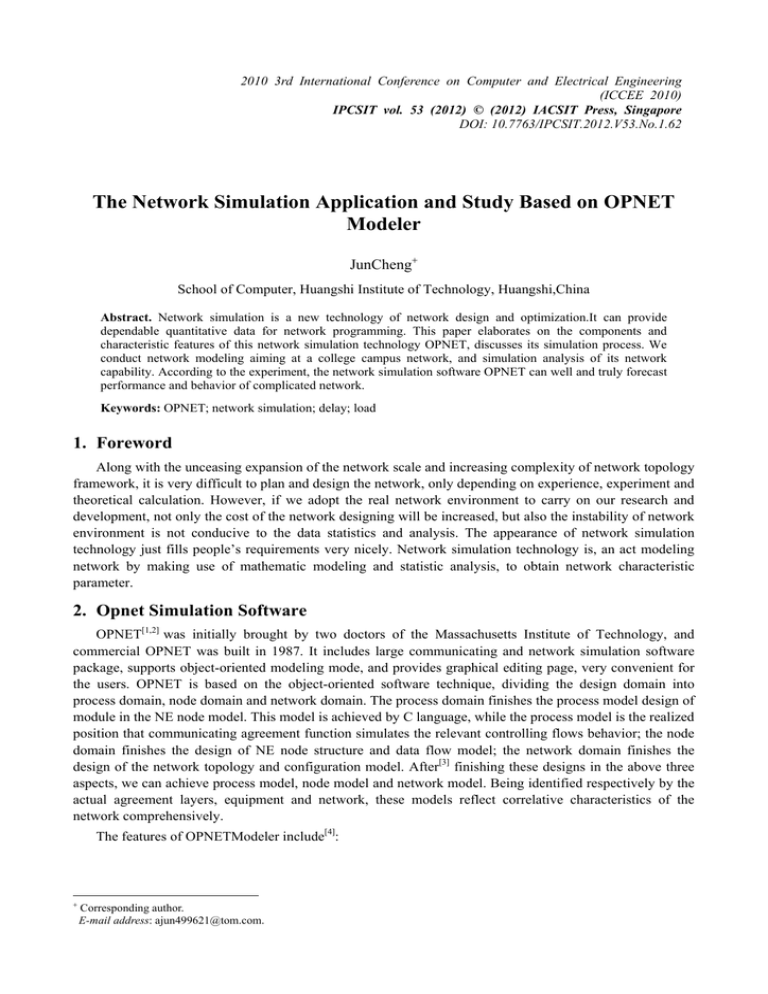Document 13136182
advertisement

2010 3rd International Conference on Computer and Electrical Engineering (ICCEE 2010) IPCSIT vol. 53 (2012) © (2012) IACSIT Press, Singapore DOI: 10.7763/IPCSIT.2012.V53.No.1.62 The Network Simulation Application and Study Based on OPNET Modeler JunCheng+ School of Computer, Huangshi Institute of Technology, Huangshi,China Abstract. Network simulation is a new technology of network design and optimization.It can provide dependable quantitative data for network programming. This paper elaborates on the components and characteristic features of this network simulation technology OPNET, discusses its simulation process. We conduct network modeling aiming at a college campus network, and simulation analysis of its network capability. According to the experiment, the network simulation software OPNET can well and truly forecast performance and behavior of complicated network. Keywords: OPNET; network simulation; delay; load 1. Foreword Along with the unceasing expansion of the network scale and increasing complexity of network topology framework, it is very difficult to plan and design the network, only depending on experience, experiment and theoretical calculation. However, if we adopt the real network environment to carry on our research and development, not only the cost of the network designing will be increased, but also the instability of network environment is not conducive to the data statistics and analysis. The appearance of network simulation technology just fills people’s requirements very nicely. Network simulation technology is, an act modeling network by making use of mathematic modeling and statistic analysis, to obtain network characteristic parameter. 2. Opnet Simulation Software OPNET[1,2] was initially brought by two doctors of the Massachusetts Institute of Technology, and commercial OPNET was built in 1987. It includes large communicating and network simulation software package, supports object-oriented modeling mode, and provides graphical editing page, very convenient for the users. OPNET is based on the object-oriented software technique, dividing the design domain into process domain, node domain and network domain. The process domain finishes the process model design of module in the NE node model. This model is achieved by C language, while the process model is the realized position that communicating agreement function simulates the relevant controlling flows behavior; the node domain finishes the design of NE node structure and data flow model; the network domain finishes the design of the network topology and configuration model. After[3] finishing these designs in the above three aspects, we can achieve process model, node model and network model. Being identified respectively by the actual agreement layers, equipment and network, these models reflect correlative characteristics of the network comprehensively. The features of OPNETModeler include[4]: + Corresponding author. E-mail address: ajun499621@tom.com. 1) Hierarchical and modularized modeling. In the OPNET Modeler, we adopt hierarchical modeling architecture similar to actual system. The lowest layer is process domain model; the second is node domain model; the uppermost is network domain model. 2) Object-oriented modeling. OPNETModeler uses the object-oriented method. Every type of nodes uses same node model, and then sets certain parameters according to different objects. 3) Graphical modeling. OPNET adopts graphical interface, providing three-layer (network layer, node layer, process layer) modeling for the users to describe the actual system. The editors of OPNET Modeler offer not only visual models of user model and visual models of the built-in model in OPNET itself, but also abundant stopwalks for the users to transfer. 4) Finite-state machine:The event-based finite-state machine modeling, avoiding the starting point of time, uses discrete event driven simulation mechanism, which greatly improved computation efficiency. 5) Hybrid modeling mechanism: Combining the package-based analytical methods and statistics-based mathematical modeling methods, detailed analog result can be attained. In the meantime, OPNET allows the users to customize programs to strengthen the functions of these statistical works, and output the simulation result in the form of file and image. 6) Openness of the system: All the source codes in the OPNET Molder are open, with an extreme clear definition of every single one, so that the users can understand the eternal work of the agreement more easily. 3. Simulation Process of Network Planning and Designing First it is required to have an all-sided acquaintance with the simulation object, and have an understanding of the editing and using norms of simulation software. Then make clear the simulation task and select the simulation content. The steps[5] of simulation are as follows: 1) Collect and analyze the information of network engineering design, including network topology, network agreement and standard, network equipment, network link characteristics, network application and its discharge characteristics. 2) Conduct tentative network planning and designing, according to experience and calculation. 3) Build up the object model. We modify the existing equipments in the basic model library, according to the interface of network equipment, in order to optimize the network equipment model. As for the equipments which are not included in the basic model library, we develop new network equipment model. 4) Set up network model. For the newly-built network, we select appropriate network node and links from the model library to establish network model; as for the networks needing an upgrade, we modify network topology or equipment on the basis of existing network models. 5) Establish network flows model. In the OPNET, the network flows are divided into background routing flows, background utilization flows and prospect business flows. Have built network topology structure, we establish relevant flow model based on the requirement of actual design. 6) Design and circulate stimulatingly. After establishing topology and leading-in network data flows, we select the statistics parameters of network property we are about to collect, fix the simulation parameter and then circulate simulation. 7) Choose the network design plan to construct, on the basis of simulation results. 8) After finishing the project, we can do actual test to testify the network system, to check whether the desired performance index is achieved or not. 4. The Simulation Application in a Campus Network A campus network [6], a total of 30 terminals, using star topology, and have a server. Now want to add another star topology (15 terminals) connected to the local area network and the original local area network. Now want to know the newly added load increases as the local area network performance will drop if a lot, so the network can not function properly. This example is used inside the project OPNET Modeler simulation analysis of the editor. By analyzing the server's load and the network delays, analysis and conclusions.The original and new campus networks are shown in the figure 1 and 2: Figure 1: the original campus network / Figure 2: the new campus network Figure 3: load of the network Having built network simulation model, it is required to collect simulation parameter. In the light of the purpose of simulation, its tasks are analyzing the program of the new campus network program, and the influence that it has to load of the campus setting and network delay, to decide the structure and size of the new campus network.Therefore, the parameters must be fixed before the simulation circulates: the load of the server node Sever and global variables. We circulate the simulation after fixing the parameter. The simulation result is shown in figure 3 and 4. As is shown in figure 3, the maximum load of the new network becomes 6000bit/s after adding up the new local area network, while the original one is 10500bit/s. when the system has a good stability, the load of the new network server fluctuates around 5000 bit/s while the original one fluctuates about 2500 bit/s. from the figure 4, the simulation results of the two network delay have no significant difference, both of which fluctuate around 0.0004s. Figure 4: network delay 5. Conclusion As we can see from the simulation results, even if load of the network is increased by adding up a campus network to a new local area network, the delay keeps basically the same. The network system of the new campus building, through testing of the school network center, every of its property indexes is up to the design requirement, capable to meet the job demand. 6. Reference [1] Long Hua, OPNETModeler and Computer Network Simulation [M].Xi’an: Xi’an University of Electronical Science and Technology Press,2006. [2] ChenMin,OPNET Network Simulation[M].Beijing: Tsing University Press, 2004. [3] SALAHK,ALKHORA IDLY A.An OPNET-Based Simulation Approach for Delploying VoIP[J]. International Journal of Network Management, 2006, 16 (3):159—183. [4] Wang Wenbo, Zhang Jinwen. OPNET Modeler and Network Simulation[M].People’ Beijing Post and Telecommunications Press.2003 [5] Gong Ping, Zhang Weguo, Gu Xiaoming. OPNET-Based Research and Simulation of Broadband Network Flows Modeling [J]. Military Communications Technology, 2003, 24(1):26 30. [6] Shi Huaiwei, Li Mingsheng, and so on. Application and Practice of Network Simulation Technology and OPNET [J].Application of Computer System, 2006, 3(9):49—55.




